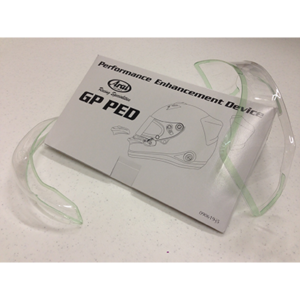Product Description
- Arai Ped Kit Installation Kits
- Arai Ped Kit Installation Parts
- Arai Ped Kit Installation Instructions
- Arai Ped Kit Installation Kit
Simply put, it's hard to imagine a better racing helmet. Combine Arai's proprietary, groundbreaking PBcLc (Peripherally Belted Complex Laminate) shell construction - the same shell shape as the F-1-grid's GP-6RC model; a wider eye port for optimized peripheral vision; new ventilation; and on and on - and you get the striking new Arai GP-6(PED). PED Clear Wicker Bill Kit by Arai Helmets® Color: Clear. Performance Enhancing Device (PED) Kit. Fits GP-5k, GP-5PED, GP-5W, SK-6, GP-6S, GP-6PED and GP-6RC. Comes with double-sided mounting tape already installed This product is made of high-quality materials. Designed using state-of-the-art technology and with customers in mind.
Constructed using Arai’s PBcLc (Peripherally Belted Complex Laminate) technology to yield incredible strength and flexibility, the Arai GP-6 PED utilizes the same shell shape as the Arai GP-6RC carbon fiber Formula 1 Helmet.
Arai’s PED (Performance Enhancement Devices) Kit is available for the Arai GP Helmets. The PED is designed to reduce lift and turbulence at high speeds by regulating the air stream OVER the helmet. The kit also increases the ventilation effect by directing more air into the ventilation slots at the front and increases the Venturi exhaust at the rear. Arai 6 series 3mm thick visor (not interchangeable with GP-5)-Removable cheek pads for a custom fit (feature emergency release tabs for easy helmet removal in an accident).-Newly sculpted chin bar and ridge along lower edge to give extra clearance above shoulders.-Includes an Arai PED kit for better aerodynamics (uninstalled).
Because of its enhanced shell strength, the Arai GP-6 PED is able to use an extremely soft and comfortable EPS liner, making this helmet as comfy as it is safe. Here’s a rundown of the features of the Arai GP-6 PED helmet:
- FIA 8858-2010 and Snell 2010 Certified
- New chin bar and lower ridge design offers improved structural integrity as well as extra clearance above shoulders and a lower center of gravity
- Removable cheek pads that allow for a custom fit
- Large 10mm intake and exhaust ports which allow for optimum airflow (front vents can be closed)
- Wide eyeport that allows for increased peripheral vision
- New positive shield locking mechanism provides solid shield latching while allowing normal operation
- Pre-drilled for HANS post installation
- Includes Arai 6 series 3mm thick visor
- Includes an Arai PED kit (performance enhancing device) for better aerodynamics (uninstalled)
Home > | Installation Guide > Luna Remote PED Installation and Configuration > Installing and Configuring a Luna Remote PED |
|---|
Installing and Configuring a Luna Remote PED

The standard Luna PED is intended to connect directly to the HSM appliance, and receives its power, as well as instructions and data via that connection. The Remote PED can act as a local PED, when needed, and connects as described previously. When used in Remote PED mode, the Luna PED 2 connects to a computer via USB, and therefore requires some additional hardware.
Remote PED can be distinguished from local PED by:
• the words Remote PED Capable on the back label
• availability of menu item [7] Remote PED from the PED's main menu.
Required Items
The following items are included with your Remote PED. All are required for a successful installation.


| Quantity | Item |
|---|---|
| 1 | Luna PED 2 (Remote PED Capable and with firmware 2.5.0-3 or greater) |
| 1 | Luna PED Power Supply kit with replaceable mains plug modules for international use (for Remote PED operation) |
| 1 | Cable, USB 2.0, Type A to Mini B connectors (for Remote PED operation). |
| 1 | Cable, Data, 9-pin, Micro-D to Micro-D connectors (for local PED operation). |
| 1 | Ten-pack of ikey 1000 PED Keys, and sheets of peel-and-stick labels |
Remote PED Setup
The Remote-Capable PED can be used either locally, connected directly to a SafeNet HSM (exactly as for the standard PED), or remotely when connected to a suitable workstation and to the electrical main power supply.
The normal local use of a PED with Remote PED capability is to use it in local mode to prepare an HSM (imprint an RPK vector – the orange key) before shipping it to its remote location. Then you can switch to Remote PED mode.
To configure the remote PED
| Step | Action |
|---|---|
| 1 | Local OPERATION [Ongoing] To use your HSM appliance and PED for local operation only, refer to the instructions accompanying your HSM, on the Luna SA documentation CD (begin by browsing the START_HERE.html page and selecting Help). |
| 2 | Local OPERATION [Preparing for Remote Use] To prepare an HSM for Remote PED operation, it needs a minimum of preparation as described in this section, below. |
| 3 | [Preliminary] Copy the PED USB driver from /USBDriver folder on the Luna PED software CD (or in the archive [tar] if you received via download) to the workstation computer that will act as the PED server to your remotely located SafeNet HSM appliances and let the Windows “Found New Hardware” dialog install it). Install PEDserver.exe software to any convenient directory on that same computer by copying it from the /Windows folder of the CD (or the archive [tar]). |
| 4 | [Preliminary] Configure your HSM appliance for your network. Refer to the other product documentation that you have received separately – in the form of WebHelp on the Luna SA documentation CD. Imprint the HSM with a Remote PED Key (orange); see below. Once the appliance can be reached via SSH and the HSM is associated with an orange PED Key, all further configuration and administration can be performed remotely. |
| 5 | To use the PED locally (for first orange PED Key imprint), connect the PED directly to the PED port of the HSM that you will later be using remotely. |
| 6 | On power-up, the PED defaults to local mode. Follow the instructions in the SafeNet HSM documentation to: • log in as “admin” to the appliance (SSH session or local serial connection) • issue the Luna shell command “hsm ped vector init”, inserting a blank (orange-labeled) PED Key into the PED, when prompted OR inserting an already-imprinted orange PED Key and select “re-use” at the PED prompt • bring the imprinted (orange) Remote PED Key to your workstation, along with a Remote-capable PED • the HSM appliance can now be shipped to its remote locale You can perform other maintenance at this time, if convenient, but only the foregoing steps were required to be done locally - all future configuration and administration can be performed remotely. |
Arai Ped Kit Installation Kits
To use the Remote PED
Arai Ped Kit Installation Parts
Once an HSM has been imprinted with a Remote PED Key (RPK) vector, you can begin administering remotely, while also authenticating remotely from any workstation that has PEDServer software and driver, a remote-capable PED, and an orange PED Key with the correct RPK (that you just imprinted in the previous steps).
| Step | Action |
|---|---|
| 1 | REMOTE OPERATION Perform the following steps to begin using your computer as a PED Server Workstation, connecting remotely to the distant HSM appliance. |
| 2 | [Prepare the PED Power Supply] On the PED power supply, slide the release catch as shown by the heavy arrow, and lift the pin protector (thinner arrow) from the power supply.
|
| 3 | Choose a plug style that is appropriate for your country and place it in the power supply, top end first, then snap the bottom end in the direction indicated by the arrow. |
| 4 | For Remote PED operation: •connect the power supply to the AC mains, •connect the DC power plug of the power supply to the DC power receptacle on the top of the PED, •connect the USB cable between the USB micro connector on the PED and a USB socket on your computer. |
| 5 | At the workstation-connected PED: •press [ < ] on the PED keypad to exit Local mode, •press [ 7 ] to enter Remote PED mode. |
| 6 | In a command-prompt window on the workstation start the PEDserver program in its listening mode c:<yourRemotePED-dir>pedserver -m start |
| 7 | Run the command pedserver –m show to verify that the PED is detected, and the system is ready for remote connection. |
| 8 | Start the PED Client - the Remote PED enabling process on the appliance (for example): lunash:> hsm ped connect -ip 192.2.12.16 - port 1503 The Remote PED Client in the HSM appliance connects with the listening PEDserver (your workstation). |
| 9 | When the PED prompts for an “rpk”, insert the imprinted Remote PED Key associated with the connecting HSM appliance, and press [Enter]. |
| 10 | Verify the Remote PED connection by performing an HSM login - the luna shell refers you to the PED. The Remote PED at your workstation prompts you to insert the blue SO PED Key(s) and press [Enter]. A successful login confirms that the Remote PED connection is running properly. |
| 11 | Begin using and administering the remotely located SafeNet HSM appliance via ssh session, and providing PED Key authentication via the workstation-connected Remote PED, whenever requested. Review the Luna SA Help for information about timeouts with respect to Remote PED. |

Arai Ped Kit Installation Instructions
Luna SA5.4.1Product Documentation
007-011136-007Rev CJuly 2014Copyright 2014SafeNet, Inc.All rights reserved.